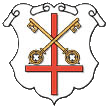|
CHRISTIAN APOSTLE PETER
Have unity of spirit, sympathy, love for one another,
a tender heart and a humble mind. Do not repay evil for evil
or abuse for abuse. On the contrary, repay with a blessing
It is said that the apostle Peter was a slender man
of a middle size and that his complexion was pale, almost
white. It is also said that he had a short thick curled
beard and thin eyebrows, or, no eyebrows at all. Peter's
eyes were black, but, flecked with red due to frequent
weeping.
Born at Betsaida, in Galilee, to a fisherman by the name of
Jona, Peter would eventually, like his father, become a
fisherman. He and his brother Andrew became partners with
Zebedee and his sons James and John in a fishing business.
All four, Peter, Andrew, James and John were to become
disciples of Jesus, later to be appointed as apostles by
him. So firm was Peter's faith, that Jesus gave him the name
of Cephas, meaning, in the Syriac language, a rock. Peter is
the Greek translation of Cephas.
The house in which Peter lived in, in Capernaum, is still
standing, however, in the 5th century AD, a Christian church
was constructed over it.
|

WORLD RELIGIONS COMPARED
WORLD
RELIGIONS CLIPART
WORLD
RELIGIONS HOME
CHRISTIAN HOME
CHRISTIAN APOSTLES |
It was Peter who preached to the masses in Jerusalem on the
day of Pentecost following the Lord's ascension to heaven
and it is his message which is recorded in the New Testament
of the Bible, the book of Acts, chapter 2. In fact, much is
written about the apostle Peter in the first 12 chapters of
the book of Acts in the New Testament.
Peter is, also, the one who prompted the disciples to choose a
replacement to take over the apostolic ministry of Judas Iscariot
(after his betrayal and death) and it was Peter who healed a man
over 40 years of age who had been crippled from birth with but the
words, "Silver and Gold I do not have, but what I have I give to
you. In the name of Jesus Christ of Nazareth, walk."
Peter was called by the apostle Paul a "pillar" of the church and it
was believed by the crowds, that the mere casting of his shadow upon
the sick, was capable of bringing about miraculous healing. Peter
is, also, the one who defended the inclusion of the Gentiles in the
Christian movement at the Apostolic Council in Jerusalem. His
ministry was primarily to the Jews, as Paul's was to the Gentiles.
After being imprisoned several times in Jerusalem because of his
faith, Peter left with his wife and possibly others. It is believed
that he ministered in Babylon to the Jewish colonists there and it
is, also, believed to be his location when he wrote his first
epistle (1 Peter).
Peter eventually went to Rome and while there, it is believed that
Mark (the writer of the Gospel of Mark) served as his translator as
he preached. It is, also, believed that as Peter told and retold his
experiences with Jesus, Mark interpreted time and time again to
Christian groups and by so doing, gave Mark an almost verbatim
memory of Peter's recollections. After Peter's death, Mark,
realizing the value of Peter's first hand account, recorded what he
remembered so clearly in what we know as the Gospel of Mark. In this
manner, Peter became the source of our earliest Gospel.
According to church tradition, the Roman Emperor Nero, publicly
announcing himself the chief enemy of God, was led in his fury to
slaughter the Apostles. Because of the persecution, Peter was
crucified upside down while in Rome. Concerning the last hours of
his life, it is said that when Peter saw his own wife led out to
die, he rejoiced because of her summons and her return home, and
called to her very encouragingly and comfortingly addressing her by
name, and saying, "O thou, remember the Lord."
Of the final days of the apostle Peter in Rome, Peter was cast into
a horrible prison called the Mamertine and for nine months,
in absolute darkness, he endured monstrous torture manacled to a
post. In spite of all the suffering Peter was subjected to, he
converted his jailers, Processus, Martinianus, and forty-seven
others. Peter met his death at the hand of the Romans in Nero's
circus, 67 AD.

Symbol - Key
St. Peter, Prince of the Apostles and brother of Andrew is
remembered each year on June 29th. He was a pillar of the Church,
its first Pope. It was believed that the mere casting of his shadow
upon the sick was capable of miraculous healing. Peter is
represented by crossed keys, which represent his role as the Holder
of the Keys to the Kingdom of Heaven. Peter was crucified by Nero in
Rome hanging upside down because he felt unworthy being crucified as
his Lord.
Nevertheless we, according to his
promise,
look for new heavens and a new earth,
wherein dwelleth righteousness.
2 Peter, 3:13

|